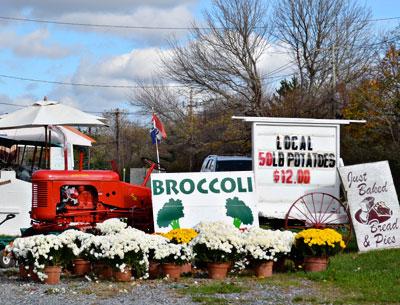Potato Harvest Time Is Here

Thousands of potatoes still sit beneath the soil, awaiting harvest and root cellar storage at Quail Hill Farm in Amagansett, which, according to Scott Chaskey, produces 20,000 pounds of the vegetable each year. To be dug and stored over the next few weeks, the crop will go primarily to winter-share members of the farm’s community-supported agriculture program, although a few local restaurants will get some as well. Varieties still to be harvested include Kennebec, Bintze, and Keuka Gold.
Mr. Chaskey, Quail Hill’s longtime farmer-in-charge, searches far and wide for the best-tasting and yielding varieties, such as Adirondack Blue, which is his personal favorite right now. “Twenty varieties have been standard for 20 years,” he said, with three to five new ones introduced at the farm each year, including blue, red, white, gold, Yukon, Carola, French red fingerlings, and Yellow Finn. Internationally, there are about 5,000 varieties of potato, Mr. Chaskey said.
There are few crops that grow so abundantly, he remarked, in diverse conditions from sea level to 14,000 feet above. Whether simply boiled with butter or mashed with garlic and olive oil, Mr. Chaskey has enjoyed potatoes since his childhood in Ireland, where his mother prepared them at almost every meal.
She was not alone. In the 1780s, farmers in Ireland grew potatoes because they fared well in poor soil and contained vitamins necessary for survival. When the crop failed in 1845, famine resulted, and many starved to death.
Late blight is what caused the Irish Potato Famine, Mr. Chaskey said. It also killed a lot of his tomatoes this year, but it has never affected the potatoes. On the other hand, potato beetles, which eat entire plants, take a lot of his time and energy. Choosing resistant varieties makes a big difference, he said; he buys seed annually from a woman in Maine who tests crops in the far north and the deep south for signs of blight.
Potato farming, which is down to 3,000 acres on Long Island from a high of 70,000, originated in South America, high in the Andes Mountains, and became a staple of North American farming in the early 18th century. Introduced by European settlers, who used the crop primarily as food for livestock and slaves, it was not until the early 20th century that cultivation began on a large enough scale to affect the local and national food supply.
It started with horse-drawn plows, then, circa 1890, farm tractors, and finally, in the 1920s, the first harvesting machines, which were pulled by horses. Once mechanized harvesters arrived in the 1950s, potatoes became a primary crop, and potato barns filled the East End.
These days, although Suffolk is still the state’s top agricultural county, much of the potato acreage has transitioned to grapes, despite their tremendously lower yield.
Johanna Halsey of the Green Thumb in Water Mill is a descendant of one of the first and largest potato growers in the area, the Halsey family, who farmed 95 acres until after World War II, when the price plummeted. Family members kept harvesting potatoes until the 1980s, when the time and expense of hand-picking beetles off the tubers made it impossible, especially after they stopped using chemicals sprays in the 1970s.
The increasing value of farmland as prime real estate also affected the production of potatoes in Suffolk, which plunged from its sixth-largest-county-in-the-nation ranking in 1969 to 49th in 1997, writes Wendy Chamberlin in “True East: Farming Ancestral Lands on Long Island’s East End.” High inheritance taxes made matters worse, she noted, as heirs were forced to sell their family farms.
Observing that “the few farmers who remain here have prevailed despite the most appetizing monetary offers,” Marilee Foster, a fifth-generation farmer in Sagaponack, wrote that “rather than fold, we chose to improvise and continue,” in her book, “Dirt Under My Nails.” She and her brother still grow potatoes, among other crops. “By the nature of our profession . . . we farmers are able to respond to changes . . . be it weather, the market, a broken piece of machinery, or infestation of pests,” she said.
